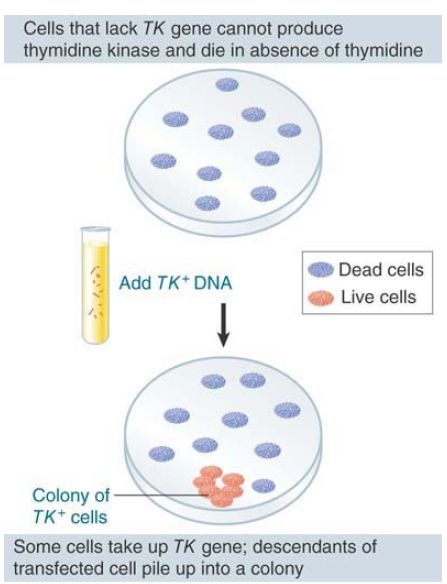


 النبات
النبات
 الحيوان
الحيوان
 الأحياء المجهرية
الأحياء المجهرية
 علم الأمراض
علم الأمراض
 التقانة الإحيائية
التقانة الإحيائية
 التقنية الحيوية المكروبية
التقنية الحيوية المكروبية
 التقنية الحياتية النانوية
التقنية الحياتية النانوية
 علم الأجنة
علم الأجنة
 الأحياء الجزيئي
الأحياء الجزيئي
 علم وظائف الأعضاء
علم وظائف الأعضاء
 الغدد
الغدد
 المضادات الحيوية
المضادات الحيوية|
Read More
Date: 4-4-2021
Date: 2-4-2021
Date: 9-12-2020
|
DNA Is the Genetic Material of Eukaryotic Cells
KEY CONCEPTS
-DNA can be used to introduce new genetic traits into animal cells or whole animals.
-In some viruses, the genetic material is RNA.
When DNA is added to eukaryotic cells growing in culture, it can enter the cells, and in some of them this results in the production of new proteins. When an isolated gene is used, its incorporation leads to the production of a particular protein, as depicted in FIGURE 1. Although for historical reasons these experiments are described as transfection when performed with animal cells, they are analogous to bacterial transformation. The DNA that is introduced into the recipient cell becomes part of its genome and is inherited with it, and expression of the new DNA results in a new phenotype of the cells (synthesis of thymidine kinase in the example of Figure 1). At first, these experiments were successful only with individual cells growing in culture, but in later experiments DNA was introduced into mouse eggs by microinjection and became a stable part of the genome of the mouse. Such experiments show directly that DNA is the genetic material in eukaryotes and that it can be transferred between different species and remain functional.

FIGURE 1. Eukaryotic cells can acquire a new phenotype as the result of transfection by added DNA.
The genetic material of all known organisms and many viruses is DNA. Some viruses, though, use RNA as the genetic material. As a result, the general nature of the genetic material is that it is always nucleic acid; specifically, it is DNA, except in the RNA viruses.



|
|
|
|
التوتر والسرطان.. علماء يحذرون من "صلة خطيرة"
|
|
|
|
|
|
|
مرآة السيارة: مدى دقة عكسها للصورة الصحيحة
|
|
|
|
|
|
|
نحو شراكة وطنية متكاملة.. الأمين العام للعتبة الحسينية يبحث مع وكيل وزارة الخارجية آفاق التعاون المؤسسي
|
|
|